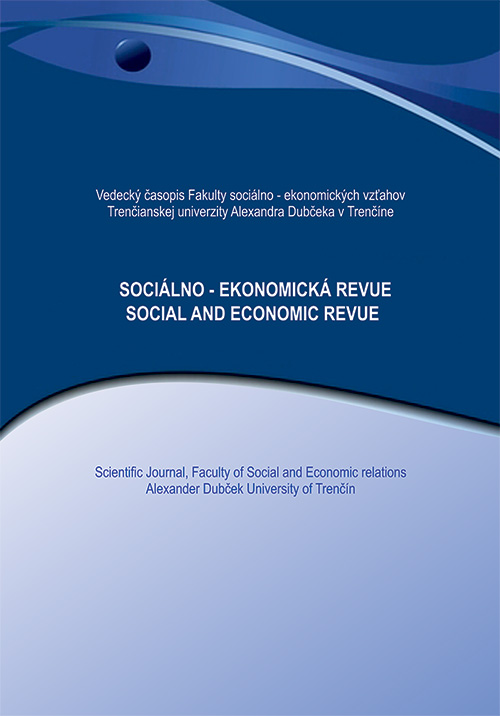ANALYSIS OF PROFITABILITY AND RISK-TAKING IN AMERICAN, EUROPEAN AND ASIAN STOCK MARKETS
Major global stock indices for different regions are dealt in this scientific article. American, European, Asian stock indices are explored according to profitability and risk. The British and German stock indices are detailed and compared to global stock indices as the most important stock indices in the European region. The price trend, profitability, volume, and risk of these stock indices over a single day are explored in more detail from January 4, 1999 to March 22, 2018, with a total time horizon of 4460 days, using Bloomberg terminal. The main purpose of the article is to analyze the profitability and risk of stock indices, to compare these indices and to forecast the trend of stock price changes. Comparison, systematization, logical grouping, methods for calculating profitability, risk, standard deviation are used in this article. Also, moving averages (short (MA21) and long periods (MA365)) are counted. The average profitability per day was the highest for the DAX stock index and the lowest for the UKX stock index. However, the highest profitability for the all analyzed period was the SPX stock index. Interestingly, that the loss would have been obtained from the UKX index over the same analysed period from 1999 to 2018. The NKY stock index was the most risky over the analyzed period, according to the standard deviation. According to the coefficient of variation, the UKX equity index had the highest risk. Floating averages reflect the correct buying and selling signals based on historical data. According to 2018 historical data, moving averages do not show optimistic forecasts, so 2018 may be particularly risky for investors. Also after analyzing the stock index price trend in 1999-2018, it can be concluded that all stock indices (SPX, SXXP, DAX, UKX, NKY) were strongly affected by the dot com bubble and the global economic crisis. The dot com bubble was the strongest hit by the DAX index price (almost four times). The lowest price for SXXP index fell (almost twice). During the global economic crisis, the price of the SPX index fell the most. The lowest price for the NKY index fell. During the period of 1999-2018, the highest upward trend was the SPX and DAX indexes. The UKX Indesque did not have a long-run trend. The highest average daily yield was the DAX index. The highest risk was the NKY index. The 2018 stock price index does not show optimistic expectations.
Release: 2019/2 Pages: 24-32 JEL classification: G15, G17, F37
DOI:
Keywords: stock indices, profitability, risk, moving averages
Section: INTERNATIONAL ECONOMICS AND POLITICS
Contacts:
PhD candidate Raminta Benetyte,
PhD student,
Kaunas University of Technology (Lithuania),
School of Economics and Business
Gedimino st. 50-405, Kaunas, Lithuania.
E-mail: raminta.benetyte@ktu.lt
Javier Giner Rubio
Professor
University of La Laguna (Spain),
Department of Economy, Accounting and Finance,
38071 Tenerife-Spain.
E-mail: jginer@ull.es
Rytis Krusinskas
Professor
Kaunas University of Technology (Lithuania),
School of Economics and Business,
Gedimino st. 50-403, Kaunas, Lithuania.
E-mail: rytis.krusinskas@ktu.lt
Literature:
Ilalan D. (2016). Elliott wave principle and the corresponding fractional Brownian motion in stock markets: Evidence from Nikkei 225 index. Journal of Chaos, Solitons and Fractals, 92. pp. 137–141.
Aubert, F., Grudnitski, G. (2014). The role of reconciliation quality in limiting mispricing of non-GAAP earnings announcements by EURO STOXX firms. Advances in Accounting, incorporating Advances in International Accounting, 30. pp. 154–167.
González-Rivera, G., Arroyo, J. (2012). Time series modeling of histogram-valued data: The daily histogram time series of S&P500 intra daily returns. International Journal of Forecasting, 28. pp. 20–33.
Ivanova K., Wille L.T. (2002). Dynamical analysis of S&P500 momentum. Journal of Physica, A 313. pp. 625-639.
Danbolt, J., Hirst, I., Jones, E. (2017). Gaming the FTSE 100 index. Journal of The British Accounting Review, pp. 1e15.
Brida, J.G., Matesanz, D., Seijas, M.N. (2016). Network analysis of returns and volume trading in stock markets: The Euro Stoxx case. Journal of Physica A 444. pp. 751–764.
Li Wenwei, Hommel, U., Paterlini, S. (2018). Network Topology and Systemic Risk: Evidence from the Euro Stoxx Market. Journal of Financial Research Letters FRL 869, pp. 1-18.
Ming-Chih Leea, Chien-Liang Chiua, Yen-Hsien Lee (2006). Is twin behavior of Nikkei 225 index futures the same? Journal of Physica, A 377. pp. 199–210.
Papaioannou, P., Dionysopoulos, T., Russo, L., Giannino, F., Janetzko, D., Siettos, C. (2017). Forecasting and trading using convolution analysis of major asset classes. Journal of Procedia Computer Science, 113, pp. 484–489
Panayotis G. Michaelidesa, Efthymios G. Tsionasb, Konstantinos N. Konstantakisa. Non-linearities in financial bubbles: Theory and Bayesian evidence from S&P500. Journal of Financial Stability, 24. pp. 61–70.
Becker, R., E. Clements, A.A., White, S.I. (2006). On the informational efficiency of S&P500 implied volatility. North American Journal of Economics and Finance, 17. pp. 139–153.
Ozturk, S.S., Richard, J-F. (2015). Stochastic volatility and leverage: Application to a panel of S&P500 stocks. Finance Research Letters, 12 pp. 67–76.
Shinhua L. (2009). Index membership and predictability of stock returns: The case of the Nikkei 225. Pacific-Basin Finance Journal, 17. pp. 338
Vamvakaris Michail D., Pantelous Athanasios A., Zuev Konstantin M. (2018). Time series analysis of S&P 500 index: A horizontal visibility graph approach. Journal of Physica, A 497. pp. 41-51.
Zhongsheng H., Bin Z. (2008). Improving density forecast by modeling asymmetric features: An application to S&P500 returns. European Journal of Operational Research, 185 pp. 716–725.


